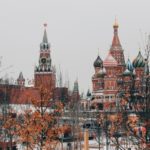The small Kyrgyz village of Baetov has become the latest site of the deployment of face-scanning cameras. And while the village has a population of only a little over 10,000 people, it may represent the latest outgrowth in a sprawling surveillance apparatus centered in Russia.

Historically, Kyrgyzstan was part of the Soviet Union until its dissolution in 1991, after which the country gained independence. But the legacy of Soviet influence has continued to shape Kyrgyzstan’s political, economic, and cultural landscape. Russian remains a widely spoken language in Kyrgyzstan, and Russia has maintained a significant influence in the country’s internal affairs.
The two nations are members of several regional organizations, including the Collective Security Treaty Organization (CSTO) and the Eurasian Economic Union (EAEU), reflecting their ongoing cooperation in security and economic matters. Economically, Kyrgyzstan is heavily reliant on Russia. Remittances from Kyrgyz migrant workers in Russia constitute a substantial portion of Kyrgyzstan’s GDP, making Russia a critical economic partner. Russia also provides significant investment and energy resources to Kyrgyzstan, reinforcing their economic ties.
Early reports of Kyrgyzstan’s deployment of facial recognition technology emerged a little over a year ago, when authorities began using it to arrest individuals who were on a watch list provided by the Russian government. The watch list reportedly had about 85,000 names on it, with Kyrgyz officials apprehending at least 57.
There is no indication that Kyrgyzstan’s facial recognition system is directly integrated with Russia’s own sprawling and sophisticated biometric surveillance apparatus, but it is arguably a de facto extension of the latter, given Kyrgyzstan’s close political alignment with Russia, and a comprehensive data-sharing agreement between the Kyrgyzstan, Russia, and Kazakhstan.
In Baetov, the new surveillance system can not only recognize faces but also license plates. Cameras are reportedly set up at the village’s entrance and in its central square, as well as at the village’s government offices.
Source: AKIpress
–
August 28, 2024 – by Alex Perala







Follow Us